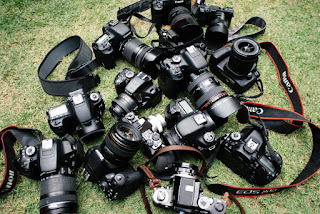Before you start shopping for a camera, you first need to understand the 3 main types of digital cameras: the digital SLR, compact (automatic) and bridge camera. In this article, you'll learn the difference between these three types of digital cameras so you can choose a camera that is right for you.
Digital Single Lens Reflexes (DSLRs)
These are the most advanced and used by serious photographers; they are expensive as well. Prices have come down considerably over the years for an entry level DSLR like the popular Canon Rebel. However, when you buy an DSLR, you also have to buy lenses. Some DSLRs do come with a basic starter lens so you'll be able to start taking pictures right away. If you want to take some pictures of something far away, you can't just push a button to zoom but will need to get a telephoto lens. These come in all sorts of sizes to fit the photographer's needs. You can also buy quality used equipment if you need to keep your costs low.
One of the great benefits of DSLRs is that you can get telephoto lenses that will let you take a close up of a bird on the top of a tree and you'll never be able to tell from the picture that the bird was so far away. And they are lightning fast! That means you won't miss actions shots because the camera took too long to record the picture after you pressed the shutter release button.
DSLRs also work with accessories like external flashes and filters to give you more options when shooting. DSLRs are great for taking action pictures in low light situations where a flash isn't allowed or won't reach.
Because of their large sensors, you can increase ISO to get pictures in low light while still having a high shutter speed to capture action. Other camera's smaller sensors mean that when you increase ISO sufficiently to get these shots, you end up with digital noise, a colorful, unsightly graininess. This can sometimes be removed with software but the DSLR allows you to avoid the whole mess.
These days, the main disadvantage of a DSLR is the higher price tag when you compare it to other types of cameras.
It's a nice camera to upgrade to if you discover you really love taking pictures and want to advance. Many get started with a camera body and kit lens, and then add bigger lenses over time.
Point & Shoot Digital Cameras (also called compact or automatic cameras)
These are best suited to the casual users. Digital compact cameras (or point and shoots) are the most popular type of camera for good reason. Compact cameras can take such good quality pictures these days that many professional photographers will also use compact cameras for when they don't want to carry around their DSLR gear. (Pocket size compacts are often called subcompacts).
As mentioned above, compacts biggest benefits is their small and compact size. Unlike DSLRs which usually require a small bag of camera gear (if you have a couple of lenses) these cameras can go virtually anywhere.
And while you can just point and shoot with these cameras, many have all sorts of modes from which to choose, and plus some also give you some manual controls, such as Aperture Priority and Shutter Speed Priority. If it has optical zoom, you can also get some great telephoto shots too!
Bridge Cameras
These are for the more serious photographers but who want a compact sized product. These digital cameras bridge a gap between compact cameras and DSLRs. They are considered a blend between professional and consumer so they're also called "prosumer" cameras.
Most bridge cameras are more expensive than compacts but are less expensive than most Digital SLRs as you won't have to buy extra lenses like with a DSLR.
Bridge cameras have larger sensors and offer more mega pixels than most compacts. Because of the larger sensor, you can increase ISO more than on a compact but not nearly as high as with an DSLR. If you don't need to get action shots in places without good lighting, this may never be an issue.
Many bridge cameras have hot shoes to work with external flash, meaning you can get better indoors pictures. Bridge cameras also have movie mode and let you compose pictures on the LCD screen. Many also have super zooms. This means they have optical zoom ranges of 10x to 20x. Plus bridge cameras have almost or as many manual controls as DSLRs.
Once you know what type suits your needs best, selecting a camera is less confusing. When you get your new camera, make sure to take time to learn how to use your camera properly so you'll be able to start taking some great pictures right away.
Paul Fraser
